When you look at WWII, historians, and military people will say, this is what won the war, or that is the reason. Some people say it was the M2 .50 cal machine gun or the Jeep or the M1 Grand rifle. I think there is an excellent argument for all of those things and more. But there were also some fantastic feats of engineering. There were a couple of reasons that the Germans didn’t think that the Allies would land at Normandy. Some of it had to do with the deception plan the Allies used, like having Patton be in charge of a fake Army in the north of England. The other reasons was the fact that there was not a deep-water harbor close enough to make it worthwhile. But the Allies had a secret plan to build their own harbor. The Mulberry harbors were temporary mobile harbor developed during World War II for unloading troops and supplies during the Allied invasion of Normandy.
The British developed them from lessons learned during the ill-fated Dieppe raid two years prior. The Brits discovered that quickly capturing a well-defended port was impossible. They were formed in secret and sunk all over England so they wouldn’t be seen.

After the successful landing and the establishment of beachheads on D-Day, two Mulberry harbors’, previously constructed in secret at various sites across the UK, were taken in parts across the English Channel and reassembled off Omaha Beach and Gold Beach. Within 12 days of the invasion, the harbors were up and running. The Mulberry Harbor was broken down into three different areas, the Breakwater, the Pierheads, and the Roadways.

The Breakwaters were made from a combination of sinking 70 older merchant ships, steel, and concrete caissons, and concrete type crosses used to help keep it all in place. The breakwater was about 9.5 kilometers long(about 6 miles). In from that was the Pierhead that the ships could tie off to, the last part was the roadways that lead into the shore and was used for the offloading of the personal and supplies to the beach.
Along with the components of the mulberries, the harbors were protected from swell and waves by blockships deliberately sunk adjacent to the harbor. You can still see parts of the huge concrete blocks sitting on the sand, and more can be seen further out at sea. I have significantly simplified how they were made and what went into them. I am not an engineer and a hell of a lot more when into making the then I talked about.

The Mulberry harbors were intended to be used until a French port could be captured. It was not until six months after D-Day that the port of Antwerp in Belgium was captured. The Mulberry harbor at Omaha Beach was abandoned after it was damaged in a storm on the 19th of June 1944, but the harbor at Gold Beach continued at nearly full capacity for ten months after the invasion. The British Mulberry supported the Allied armies for ten months. Two and a half million men, a half-million vehicles, and four million tons of supplies landed in Europe through the artificial harbors at Arromanches.


This is history I didnt know
Thanks
The ones for Op Coronet & Olympic would have been impressive.
Or, as Gen. Omar Bradley said (possibly attributed): “Amateurs talk strategy. Professionals talk logistics.”
What is amazing is the sense of urgency on how fast things were done then. Imagine if we had to come up with that solution today, how long would it take etc…..
It is really cool to see their remnants from the beaches.